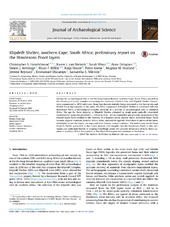| dc.contributor.author | Henshilwood, Christopher | eng |
| dc.contributor.author | Van Niekerk, Karen Loise | eng |
| dc.contributor.author | Wurz, Sarah Jacoba Deborah | eng |
| dc.contributor.author | Delagnes, Anne | eng |
| dc.contributor.author | Armitage, Simon | eng |
| dc.contributor.author | Rifkin, Riaan | eng |
| dc.contributor.author | Douze, Katja | eng |
| dc.contributor.author | Keene, Petro | eng |
| dc.contributor.author | Haaland, Magnus Mathisen | eng |
| dc.contributor.author | Reynard, Jerome | eng |
| dc.contributor.author | Discamps, Emmanuel | eng |
| dc.contributor.author | Mienies, Samantha | eng |
| dc.date.accessioned | 2014-12-10T14:51:34Z | |
| dc.date.available | 2014-12-10T14:51:34Z | |
| dc.date.issued | 2014 | eng |
| dc.identifier.issn | 0305-4403 | |
| dc.identifier.uri | https://hdl.handle.net/1956/8896 | |
| dc.description.abstract | Surveys for archaeological sites in the De Hoop Nature Reserve, southern Cape, South Africa resulted in the discovery of a cave complex comprising two locations, Klipdrift Cave and Klipdrift Shelter. Excavations commenced in 2010 with Later Stone Age deposits initially being recovered at the former site and Middle Stone Age deposits at the latter. The lithic component at Klipdrift Shelter is consistent with the Howiesons Poort, a technological complex recorded at a number of archaeological sites in southern Africa. The age for these deposits at Klipdrift Shelter, obtained by single grain optically stimulated luminescence, spans the period 65.5 ± 4.8 ka to 59.4 ± 4.6 ka. Controlled and accurate excavations of the discrete layers have resulted in the recovery of a hominin molar, marine shells, terrestrial fauna, floral remains, organic materials, hearths, lithics, ochre, and ostrich eggshell. More than 95 pieces of the latter, distributed across the layers, are engraved with diverse, abstract patterns. The preliminary results from Klipdrift Shelter presented in this report provide new insights into the Howiesons Poort in this sub-region and contribute further to ongoing knowledge about the complex behaviours of early Homo sapiens in southern Africa. Excavations at the Klipdrift Complex will continue in the future. | en_US |
| dc.language.iso | eng | eng |
| dc.publisher | Elsevier | eng |
| dc.relation.uri | http://www.sciencedirect.com/science/article/pii/S0305440314000430 | eng |
| dc.rights | Attribution-NonCommercial-NoDerivs CC BY-NC-ND | eng |
| dc.rights.uri | http://creativecommons.org/licenses/by-nc-nd/3.0/ | eng |
| dc.subject | Middle Stone Age | eng |
| dc.subject | Howiesons Poort | eng |
| dc.subject | Homo sapiens | eng |
| dc.subject | modern human behaviour | eng |
| dc.subject | coastal subsistence | eng |
| dc.subject | Southern Africa | eng |
| dc.title | Klipdrift Shelter, southern Cape, South Africa: preliminary report on the Howiesons Poort layers | eng |
| dc.type | Peer reviewed | |
| dc.type | Journal article | |
| dc.date.updated | 2014-12-08T15:18:05Z | en_US |
| dc.description.version | publishedVersion | |
| dc.rights.holder | Copyright 2014 The Authors | |
| dc.identifier.doi | https://doi.org/10.1016/j.jas.2014.01.033 | |
| dc.identifier.cristin | 1100980 | |
| dc.source.journal | Journal of Archaeological Science | |
| dc.source.40 | 45 | |
| dc.source.14 | 1 | |
| dc.source.pagenumber | 284-303 | |
| dc.subject.nsi | VDP::Humanities: 000::Archaeology: 090 | |
| dc.subject.nsi | VDP::Humaniora: 000::Arkeologi: 090 | |

